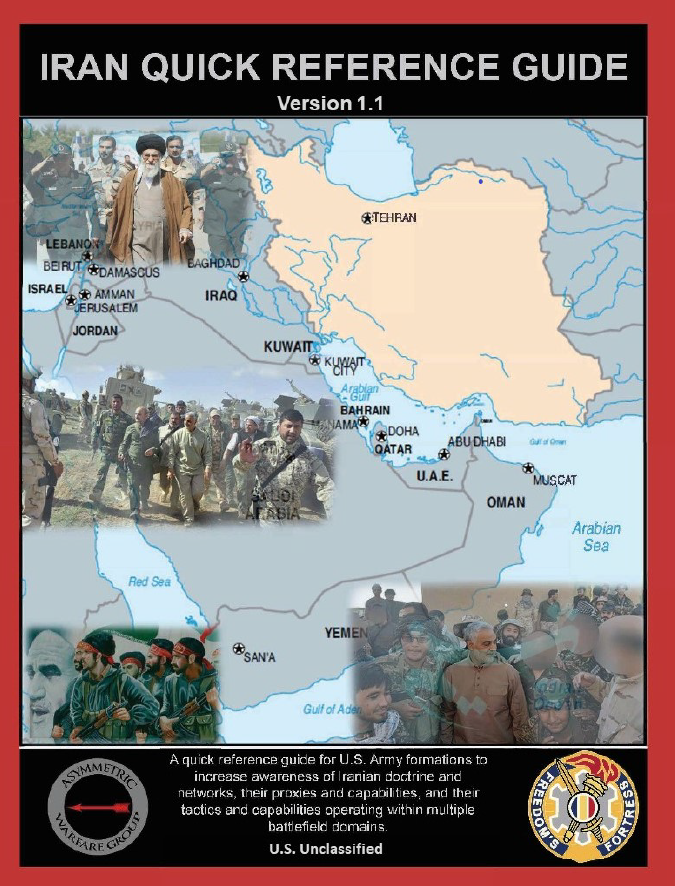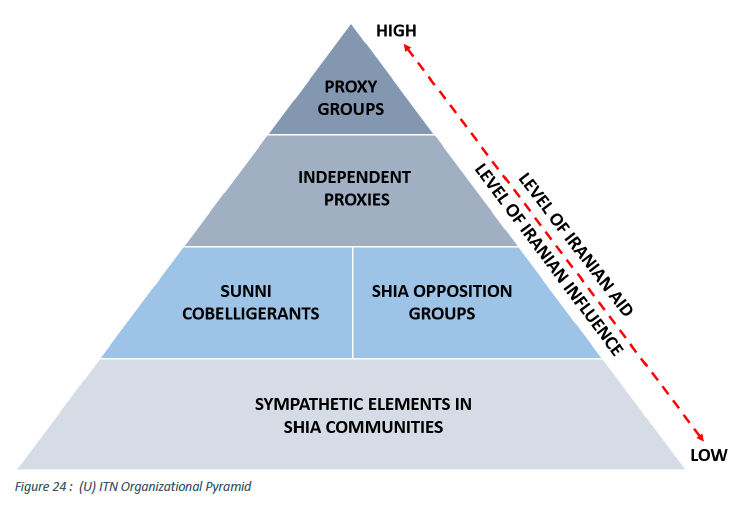(U) Since its inception in 1979, the Islamic Republic of Iran has repeatedly disrupted the stability of the Middle East and fostered terrorist threats throughout the world. Iran exploited the power vacuum which followed the Iraq War in 2003 and Arab Spring in 2011 to significantly extend its regional influence, primarily through the establishment of proxy groups and new relationships with existing regional terrorist groups. International sanctions against Iran, levied in response to Iran’s support for terrorism and nuclear activities, constrained Iran’s actions, but did not end them, nor did they stop Iran from enhancing its conventional military enterprise.
(U) In response to its lack of state allies and the conventional military capabilities of its neighbors, the United States, and other Western powers, Iran adopted a military paradigm in which it would rely on asymmetric responses, often using unconventional tools, to include terrorism. Iran often employs a paramilitary element of its Revolutionary Guards known as the Quds Force to lead or conduct many of these operations.
(U) This power expansion offers new options for Iran to attack potential adversaries as well as the ability to add strategic depth to its regional defense architecture. Despite renewed international and regional pressure, Tehran shows no sign of ceasing this behavior.
(U) U.S. diplomatic and military personnel will be best able to respond to Iranian threats by understanding the tools at its disposal. The following reference guide provides an excellent overview of the equipment, personnel, and practices which play important roles in Iran’s external power projection. Developing an understanding of these capabilities will enable readers to predict Iranian behavior and understand the weaknesses inherent in its operations.
…
1.3 – (U) Executive Summary
(U) Iran’s objectives are to maintain the recently established land bridge that runs between Iran through Iraq and Syria into Lebanon, limit the influence of Sunni states and Israel, and expel US and Western influence from the region.
(U) Iran’s strategic geographic location enables it to threaten vital US interests in the Strait of Hormuz and the greater Gulf region and influence the Bab al-Mandab and Eastern Mediterranean.
(U) Iran is the world’s largest state sponsor of terrorism and is actively destabilizing the Middle East through its proxy operations.
(U) Iran’s military doctrine focuses on Hybrid Warfare operations and asymmetric response options aimed at reducing the will of the United States and its partners to fight in the region.
(U) Iran’s large military enterprise is split into two separate forces: the Iranian Army and the Iranian Revolutionary Guard Corps (IRGC). Iran maintains the largest ballistic missile program in the region.
(U) Iran’s Islamic Revolutionary Guard’s Qods Corps (IRGC), influences or directs the operations of a network of proxy groups and terrorist organizations referred to hereinafter as the Iranian Threat Network (ITN).
(U) Iran’s distributed network of proxies have reduced Iran’s official footprint while allowing Iran considerable influence in Iraq, Syria, Lebanon, Yemen and western Afghanistan.
(U) Iran has a relatively advanced and capable drone program.
(U) Iran has begun to export advanced missile technology to the Houthis and Lebanese Hezbollah.
(U) Iran has developed signature TTPs that are being used by both its forces and Iranian proxies in Syria, Iraq, and Yemen.
(U) Iran is developing a growing cyber warfare capability and maintains a sophisticated information operations capability.
(U) IRGC Qods Force and Lebanese Hezbollah operatives conduct the majority of their activity in the CENTCOM AOR, but maintain at least a support capacity in every COCOM AOR and have the capacity to deploy personnel, if needed.
…
(U) Iran’s military Doctrine focuses heavily on Asymmetric Warfare and is a hybrid of Western military concepts coupled with Shiite revolutionary ideology. The Western influence is a doctrinal remnant of Iran’s pre-revolution relationship with the U.S. military. In the early 1970s, Iran was aligned against the Soviet Union and the largest purchaser of US military equipment, and received commensurate training and assistance from the United States – the Iranian military still uses a great deal of dated US equipment. Western observers should not make the mistake of dismissing the importance of the Islamic revolution in the doctrine of Iran – the role of Islam in the military is enshrined in the Iranian constitution, and officers are groomed and selected for promotion not only on tactical aptitude but on religious credentials.
…
(U) Iranian Hybrid Warfare
(U) Since 2003, and in large part due to operations in Afghanistan and Iraq, U.S. personnel have been increasingly familiar with the concept of asymmetric warfare as the U.S. faced adversaries unable to confront the U.S. conventionally. In its simplest form, asymmetric warfare is may be described as a competition between adversaries who adjust tactics, techniques and procedures to exploit their respective strengths and opponents’ vulnerabilities. Asymmetric Warfare, as Iran practices it, is a holistic strategy designed to overcome Iran’s inability to match U.S. conventional power and resources by using tactics which exploit perceived Western vulnerabilities. The tools employed in this strategy are described as Hybrid Warfare.
(U) Hybrid war is the combination of activities through attributable but deniable operations, proxies and technologies designed to destabilize a target and achieve objectives short of war; importantly, its techniques can leverage conventional and attributable capabilities in threatening ways that reinforce the attributable but deniable efforts. A fait accompli campaign is intended to achieve military and political objectives rapidly, creating irreversible facts on the ground – before an adversary can respond. In addition to the associated psychological defeat, a successful hybrid warfare campaign can be used to reduce, if not deny, adversary response options. Finally, the costs of hybrid warfare are far less than a conventional conflict, an important advantage for resource-constrained Iran.
…
(U) ITN Proxy Group Development
(U) Iran follows a consistent model in its development of proxy groups and partners. Iran has had its greatest success in areas which enjoy four characteristics: a collapse of the state structure, Shi’a threatened by Sunni extremists, a logistics pipeline through which Tehran may maintain operations, and the absence of significant external powers which will block Iran’s actions.
(U) Iran has also been known to exploit grievances among Shia populations, particularly during situations of real or perceived threats to these populations that play into Iran’s “resistance” narrative. Once an opportunity is identified, Iran will offer training and indoctrination to militant candidates in Iran, and then channel money, arms and/or other forms of support in order to build dependency. As the targeted group demonstrates a capability to conducted more advanced operations and its leadership is trusted by Tehran, Iran is able to gradually begin shaping their operations towards Iranian objectives. As a pragmatic facilitator, Iran is likely to go through this cycle numerous times with various groups, but probably works to maintain at least low-level relations with as many ideologically aligned groups as possible in order to maintain flexibility for future contingencies where a group could suddenly become more important in the scope of Iranian strategy. As Iran’s priorities shifts or global events develop, they may increase or decrease funding and support while still working to maintain their influence.
(U) The Iranian Threat Network is comprised of six distinct elements. The IRGC Qods Force exercises control over proxy operations, reporting only to the Supreme Leader. The Qods Force also controls the remaining five elements, which form the taxonomy of the ITN.
(U) Iran Proxy groups over which Iran exerts preponderant influence, e.g., Lebanese Hezbollah and Kata’ib Hezbollah
(U) Independent proxies, or semi-controlled partners, which have an independent decision-making process but are influenced by Iran, e.g., the Houthis and Taliban
(U) Sunni armed groups that are cobelligerent with Iran, e.g., Hamas
(U) Shia armed opposition movements that oppose Sunni or secular governments and are supported but not fully controlled by Iran, e.g., Bahraini Shia
(U) Shia communities worldwide, which are often supported by Iran in the cultural and religious fields and are viewed by Tehran as potential bases of support for its policies
…


